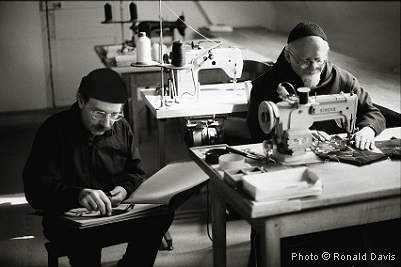
|
Monastic Journey
Continued |
|||||
Monastic Journey Continued
Stanley Roseman
The MONASTIC LIFE
The MONASTIC LIFE
Roseman's oeuvre on the monastic life - a monumental and critically acclaimed work that includes the four monastic orders of the Western Church - was begun in 1978 and extended through the years with cordial invitations from monasteries he had not been to before and repeated invitations to return to monasteries he knew well. The monks' and nuns' high esteem for the artist's paintings and drawings; their admiration for his knowledge of monastic history; and their appreciation of his own contemplative nature brought Roseman enduring friendships and continuing encouragement to take up again his work in their monasteries.
''With a seriousness that pushes him always further in treating a subject or theme,
he continually clarifies and refines, never letting his interest waiver or diminish.''[1]
he continually clarifies and refines, never letting his interest waiver or diminish.''[1]
- Bibliothèque Nationale de France
2. Frère Tarsicius, Portrait of a Trappist Monk in Prayer, 2002 Abbaye de La Trappe, France
Oil on canvas, 60 x 50 cm
Collection of the artist
Oil on canvas, 60 x 50 cm
Collection of the artist
The Abbey of La Trappe, in Normandy, gives its name to the branch of Cistercian monasticism called the Order of Cistercians of the Strict Observance, also known as the Trappist Order.
Frère Samuel,
Portrait of a Trappist Monk in Prayer, 2002 Abbaye de La Trappe, France
Oil on canvas, 60 x 60 cm
Private Collection, France
Portrait of a Trappist Monk in Prayer, 2002 Abbaye de La Trappe, France
Oil on canvas, 60 x 60 cm
Private Collection, France
Roseman created the beautiful drawing A Trappist Monk Bowing in Prayer, (fig. 4), when he and Davis returned to the Abbey of La Trappe in December 1982. Following their sojourn, they presented the monastery with a gift of the artist's drawings which included the present work and for which the Abbot expressed his sincere appreciation.
"I thank you again for your good wishes and for the drawings
that you have generously given us.
They will be symbols of the bond that unites us,
regardless of the differences of language, religion, and life-style.
But in the most profound essentials, we are as one.''
that you have generously given us.
They will be symbols of the bond that unites us,
regardless of the differences of language, religion, and life-style.
But in the most profound essentials, we are as one.''
- Abbot Gérard Dubois
Abbot of La Trappe
Abbot of La Trappe
4. A Trappist Monk Bowing in Prayer
1982, Abbaye de La Trappe, France
Chalks on paper, 50 x 35 cm
Collection Abbey of La Trappe
1982, Abbaye de La Trappe, France
Chalks on paper, 50 x 35 cm
Collection Abbey of La Trappe
Returning to the Abbey of La Trappe,1982
Abbot Gérard thoughtfully made the library available to Roseman for research and study, and several of the monks kindly assisted the artist with information on the history of the Abbey and on Trappist monasticism. During the 1980's, with encouragement from the monks, Roseman was much engaged in writing a text to accompany his paintings and drawings on the monastic life.[3] The following are excerpts from the artist's manuscript where he speaks about the Abbey of La Trappe and his work at the monastery:
A Painting Studio at the Abbey of La Trappe
"Père Hugues thoughtfully provided me with a worktable for my paint brushes, tubes of oil paint, cans of turpentine, and jars of paint medium, as well as chairs for me and my models. The Prior moved the monastery's artifacts to one side of the room to give me maximum space in which to paint.
7. Stanley Roseman painting in his studio
at the Abbey of La Trappe, 2002.
at the Abbey of La Trappe, 2002.
Roseman in company with his colleague Ronald Davis made their first sojourn at the Abbey of La Trappe in June of 1979. "Being invited to the Abbey that is the fountainhead of Trappist monasticism,'' recounts Roseman, "was of great significance to my work on the monastic life.
"Ronald, who had been writing the letters on our behalf to explain the nature of our request for a visit, received a warm letter of invitation signed by Frère Élie, the doorkeeper. That was the first time Ronald and I had received a letter of invitation from the porter of a monastery. We appreciated the sense of monastic history attached to such a letter, for the Rule of St. Benedict dedicates a chapter (Chapter 66) to the porter of the monastery and counsels that at the monastery gate should be a wise man of years who knows how to receive and give messages.[2] (See the drawing of Frère Elie on "Correspondence from the Monasteries.")
A History
Roseman and Davis returned to La Trappe later that summer after sojourns at the Abbey of Solesmes, along the River Sarthe; and the Abbey of Le Bec, in Normandy. From La Trappe, they traveled south to the Abbey of Fleury, along the Loire; and the Abbey of Cîteaux, in Burgundy, before going on to monasteries in Spain.
"The observance of monastic life at the Abbey of La Trappe in the seventeenth century had a profound influence on the development of Cistercian monasticism.
5. Stanley Roseman drawing Père Robert in the tailor shop
at the Abbey of La Trappe, 1998.
at the Abbey of La Trappe, 1998.
First Sojourn at the Abbey of La Trappe, 1979
"Frère Élie writes: 'It is with great pleasure that we shall receive your friend Stanley Roseman and yourself in our monastery.' Ronald, whose maternal ancestry is French and was raised in the Roman Catholic faith, was equally looking forward to beginning our monastic journey in France at the Abbey of La Trappe.
The room was located on the second floor of an eighteenth-century stone building, with several of the monks' workshops below in an adjacent building that extended to the gatehouse. Roseman recounts:
6. Courtyard of the Abbey of La Trappe with its eighteenth-century stone building where Roseman painted in his studio on the second floor.
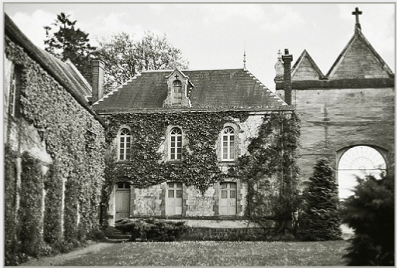
"Inspired by accounts of early monastic life in the deserts of Egypt and Syria, Rancé established a rigorous spiritual asceticism at La Trappe. The monks devoted long hours to meditation and personal prayer, in addition to the communal worship in choir; maintained an abstemious diet with fasting; and practiced self-denial, penance, and strict silence.
The Artist and the Trappists
"My studio at La Trappe had white walls and windows with a southern exposure to the courtyard and a northern exposure to the church and conventual buildings. The northern exposure brought ideal daylight for painting portraits.
3. The Abbey of La Trappe, Normandy, 1979.
"On the afternoon of June 4th, with the dates for our sojourn confirmed, Ronald and I arrived at the Abbey of La Trappe, situated in the rural countryside of Normandy. The tall, neo-Gothic church tower rose above the complex of living quarters, workshops, guest house, gatehouse, and numerous farm buildings that accommodated a dairy herd, a main source of income for the monastery.
Monastic Journey Continued
The Abbey of La Trappe - Source of Trappist Monasticism
© Stanley Roseman and Ronald Davis - All Rights Reserved
Visual imagery and website content may not be reproduced in any form whatsoever.
Visual imagery and website content may not be reproduced in any form whatsoever.
At the Abbey of La Trappe in 2002, Roseman was thoughtfully offered a room as a painting studio. The Prior Père Hugues, like Abbot Gérard, was greatly encouraging and appreciative of the artist's work on the monastic life and appropriated for Roseman a room in a building adjacent to the inner gate of the monastery courtyard.
"I appreciated having in my studio the monastery's old farm and carpentry tools and other work tools, including pressing irons used by previous generations of tailor-monks. Those tools gave the studio a sense of the monastery's history while I painted a present generation of monks at the Abbey of La Trappe."
In a deeply moving letter from Abbot Gérard Dubois to Stanley Roseman, who is of the Jewish faith, the eminent Abbot of La Trappe writes (here translated from the French):
A PAINTING STUDIO at the ABBEY of LA TRAPPE
At the outset of their journey in the spring of 1978, Roseman and Davis were invited to their first Trappist monastery, Mount St. Bernard Abbey, Leicestershire. There Roseman created a series of impressive paintings of the monks, which includes Father Ian, Portrait of a Trappist Monk in Meditation, "an absolutely captivating work'' writes the distinguished curator Pierre Barousse in acquiring the painting for the Musée Ingres, Montauban. The painting is seen on the page "The Monastic Life,'' (fig. 8), relating the artist's work that spring and summer at St. Augustine's Abbey, a Benedictine monastery in Ramsgate, and Mount St. Bernard Abbey.
Roseman's work on the monastic life brought him over the years into a number of Trappist monasteries in Europe, including returns to the Abbey of La Trappe in 1997 and 1998. The artist's sojourn at La Trappe in 2002 gave him the wonderful occasion to create again a series of paintings of Trappist monks.
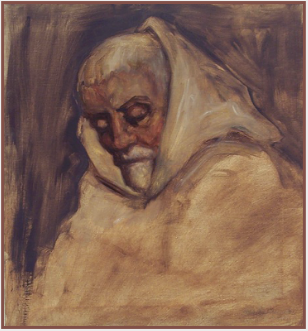
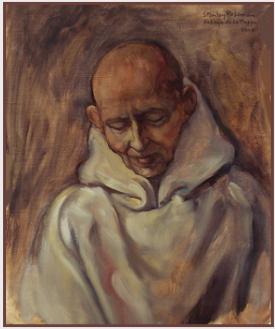
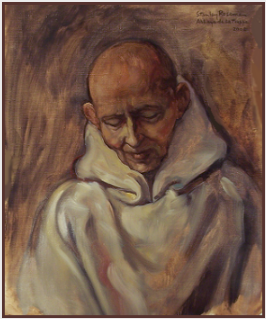
Portraiture
Roseman's long and creative association with the Abbey of La Trappe began in 1979, with sojourns at the monastery over the years in the continuation of his work on the monastic life.
Returning to La Trappe in 2002, Roseman was thoughtfully offered a painting studio. The result of several months' work is a series of superb paintings of members of the community. Frère Samuel, Portrait of a Trappist Monk in Prayer, is presented at the top of the page, and Frère Tarsicius, Portrait of a Trappist Monk in Prayer, is seen here, (fig. 2). The paintings are also presented below on this page, along with a portrait of Père Christian (fig. 10) and accompanying texts from the artist's journal.
"The warm welcome and gracious hospitality we received from Abbot Gérard Dubois and the monks and the great encouragement given to Ronald and me in our work meant very much to us.''
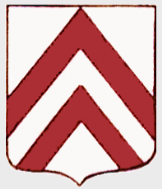
"Armand-Jean Le Bouthillier de Rancé, born in 1626 of an aristocratic family, pursued an ecclesiastical career as his family had intended for him. However, in his thirties, Rancé felt a calling to the contemplative life. After a few years of reflection, which included a visit to La Trappe in the summer of 1658, he divested himself of his properties and benefices; received royal permission to transfer his hereditary title of commendatory abbot of La Trappe to that of regular abbot; entered the novitiate at the Abbey of Perseigne, near Alençon; and, after a year, made his monastic profession. In 1664, Rancé returned to the Abbey of La Trappe.[4]
Abbey of La Trappe
Coat of Arms
Coat of Arms

8. Frère Samuel,
Portrait of a Trappist Monk in Prayer
2002, Abbaye de La Trappe, France
Oil on canvas, 60 x 60 cm
Private collection, France
Portrait of a Trappist Monk in Prayer
2002, Abbaye de La Trappe, France
Oil on canvas, 60 x 60 cm
Private collection, France
11. Frère Tarsicius,
Portrait of a Trappist Monk in Prayer
2002, Abbaye de La Trappe, France
Oil on canvas, 60 x 50 cm
Collection of the artist
Portrait of a Trappist Monk in Prayer
2002, Abbaye de La Trappe, France
Oil on canvas, 60 x 50 cm
Collection of the artist
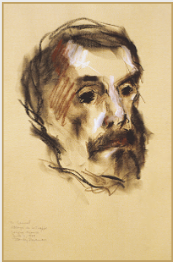
9. Frère Samuel, 1979
Abbaye de La Trappe, France
Chalks on paper, 35 x 50 cm
John Davis Hatch Collection
Abbaye de La Trappe, France
Chalks on paper, 35 x 50 cm
John Davis Hatch Collection
- ARA arte religioso actual, Madrid
Twenty-three years before Roseman painted the portrait of Frère Samuel seen above, the artist drew several portraits of the monk in June of 1979, as exemplified by the present work, (fig. 9).
The eminent American collector John Davis Hatch, Co-founder and first Director of Master Drawings Association, acquired the portrait of Frère Samuel along with the artist's portrait of Padre Hipólito, 1979, from the Trappist Abbey of San Pedro de Cardeña, Spain, and a drawing of Frère Christian at work in the kitchen, 1979, whom Roseman drew at the Benedictine Abbey of Fleury, France.
Portraiture holds an important place in Roseman's oeuvre. Aftonbladet, Stockholm, Sweden's leading daily, published in 1980 a Sunday magazine cover story on Roseman and commends him for creating portraits "artistically on a high level as well as accurately expressive of the human dimension.'' Roseman's portraits account for a major part of his work in the monasteries. The Bibliothèque Nationale de France in a biographical essay on the artist praises the work as "profoundly expressive of the individual and the interior life.''
Frère Samuel, born in 1926 in Rouen, the son of a medical doctor, entered La Trappe in 1949. When Roseman and Davis met Frère Samuel in 1979, he was manager of the Abbey's large dairy farm. Roseman further recounts:
"I remember that first sojourn at La Trappe and Frère Samuel thoughtfully inviting Ronald and me to visit the farm facilities and watch the cows being called in from the field for milking. Farming has been a traditional occupation in Cistercian monasteries since the beginning of the Order in the closing years of the eleventh century. The farm at La Trappe, with over a hundred dairy cows, provided the monastery with its main source of income. Being in retirement in 2002 from his work on the farm, Frère Samuel generously gave of his time to sit for me in my studio at La Trappe."
Presented here, (fig. 8), is the magnificent oil on canvas painting entitled Frère Samuel, Portrait of a Trappist Monk in Prayer. The bold abstraction of the white cowl is in striking contrast to the chiaroscuro modeling of the face of the monk with a ruddy complexion from years of work on the farm, his head inclined and his eyes lowered as he prays.
The artist rendered the monk's portrait in a palette of earth colors complemented by glazes of warm, white tones of the cowl; the white hood pulled up encircling the face; and bright white highlights on the monk's hair, moustache, and beard. In this deeply felt portrait of Frère Samuel, Roseman expresses serenity in the countenance of the Trappist monk who devoted his many years to a monastic life of prayer and work.
Returning to La Trappe in 1997, 1998, and 2002, the artist made a number of drawings of Frère Samuel at the Divine Office and accompanied his friend back to choir to draw the monk in personal prayer and meditation. A portrait drawing of the monk was a further gift from the artist and his colleague to the monastery.
"I was deeply touched that after a few days into my work with Frère Tarsicius, he thanked me very much for having asked him to sit for me. He said he looked forward to our afternoons together and was appreciative to be in my studio where he could meditate and pray while I painted at my easel. I too looked forward very much to our afternoons together and am grateful for having the opportunity to create several paintings of this endearing and pious monk."
1. Stanley Roseman - Dessins sur la Danse à l'Opéra de Paris (Paris: Bibliothèque Nationale de France, 1996), p. 11.
2. The Rule of St. Benedict and explanations on the text in Households of God, trans. Abbot David Parry, O.S.B.,
(London: Darton, Longman &Todd, London, 1980), pp. 180, 181.
3. The Oxford scholar and Benedictine monk Dom Bernard Green read a draft of Roseman's manuscript and wrote in a gracious letter
to the artist: "You portray the background and the aims of life in monasteries so well, showing such a deep understanding of the monastic life.''
4. L'Abbaye Notre Dame de la Grande-Trappe, authored anonymously by a monk of La Trappe, (Orne: Montligeon, 1926), pp. 65, 76, 78.
5. Louis J. Lekai, The Cistercians (Ohio: Kent State University Press, 1977), pp. 188, 189.
6. The Shorter Oxford English Dictionary (Oxford: Clarendon Press, 1973), p. 1068.
2. The Rule of St. Benedict and explanations on the text in Households of God, trans. Abbot David Parry, O.S.B.,
(London: Darton, Longman &Todd, London, 1980), pp. 180, 181.
3. The Oxford scholar and Benedictine monk Dom Bernard Green read a draft of Roseman's manuscript and wrote in a gracious letter
to the artist: "You portray the background and the aims of life in monasteries so well, showing such a deep understanding of the monastic life.''
4. L'Abbaye Notre Dame de la Grande-Trappe, authored anonymously by a monk of La Trappe, (Orne: Montligeon, 1926), pp. 65, 76, 78.
5. Louis J. Lekai, The Cistercians (Ohio: Kent State University Press, 1977), pp. 188, 189.
6. The Shorter Oxford English Dictionary (Oxford: Clarendon Press, 1973), p. 1068.
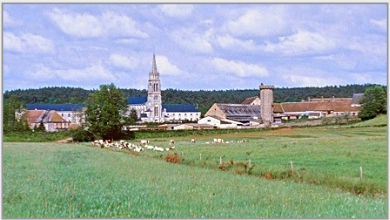
Frère Samuel writes in a Christmas-New Year card to "Cher Stanley, Cher Ronald'' to express appreciation for "le très beau portrait'' ("the very beautiful portrait'') that the two Americans presented to the monastery. "Merci encore pour votre gentillesse'' ("Thank you again for your kindness''). In closing his thoughtful card, the Trappist monk adds in English, "and very happy new year.''
In the superb painting Frère Tarsicius, Portrait of a Trappist Monk in Prayer, (fig. 11), Roseman describes the monk's cowl with brushstrokes of creamy white pigment and translucent passages of pearly grays, pinks, and pale blues, with reserved areas of the ochre ground enhancing the warm tonality of the composition. A soft, natural light illuminates the monk's cranium and face surrounded by the large hood of his cowl.
"Père Hugues, a kindly man and dear friend, prepared a sizable room as a studio for me. The room contained some of the monastery's old farm tools, carpentry tools, and other work implements the Prior was safeguarding as a collection. Included were several antique pressing irons which, as I mentioned to Père Hugues, reminded me of those collected by my father in memory of his own father, who had been a tailor on New York City's Lower East Side.
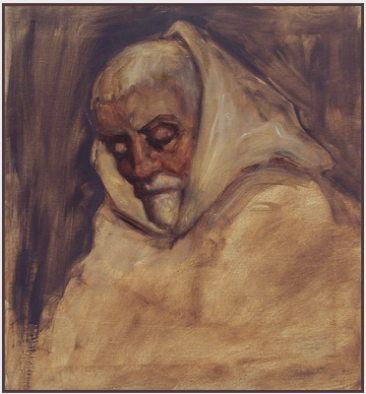

© Stanley Roseman
© Stanley Roseman
© Stanley Roseman
© Stanley Roseman
© Stanley Roseman
© Photo by Ronald Davis
© Photo by Ronald Davis
In the Artist's Studio
The artist beautifully renders the monk's face, with eyes lowered, and peaceful countenance. The portrait of Frère Tarsicius conveys a deep sense of the monk's humility and brings to mind Chapter 7 "On Humility" in the Rule of St. Benedict.
Père Christian and his twin brother Père Robert - the tailor with whom Roseman is seen in the photograph above, (fig. 5) - were twenty years old in 1944 when they bicycled from their home in Paris to La Trappe with the intent to follow a contemplative life. Their friendship with Roseman and Davis deepened over the years the artist and his colleague sojourned at the Abbey. Both Père Christian and Père Robert kindly gave of their time to sit for Roseman in his studio. The rapport between the artist and the two brothers is expressly evident in the magnificent portraits Roseman painted of them, as with the oil on canvas portrait Père Christian, (fig. 10).
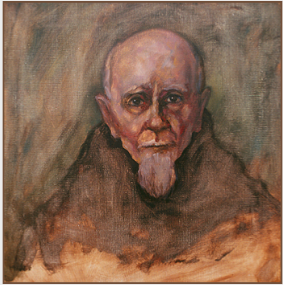
10. Père Christian, 2002
Abbaye de La Trappe, France
Oil on canvas, 50 x 50 cm
Private collection, New York
Abbaye de La Trappe, France
Oil on canvas, 50 x 50 cm
Private collection, New York
"Père Christian, a gentle, caring man," writes Roseman of his friend, "was for thirty years the Abbey's infirmarian - a word derived from monastic history, as the Oxford English Dictionary explains: 'In mediaeval monasteries, the person who had charge of the infirmary.'[6]
''The pictures - splendid and telling all at once - form the stimulating vanguard
towards so original and deep a study of the monastic life.''
towards so original and deep a study of the monastic life.''
In letter to Ronald Davis, who brought Roseman's drawings to the collector's attention, John Davis Hatch writes: "I very much appreciate Stanley's allowing me to have them - as they are great additions to my drawing collection.''

© Stanley Roseman
The drawing Père Robert at Vigils, 1982, is presented on the page "Benedictines, Cistercians, Trappists, and Carthusians," - Page 3.
"Père Christian was the first monk who sat for me in my studio, and his encouragement for my work meant very much to me. Père Christian wore his brown, woolen work habit which his brother Père Robert, the tailor, had made for him as well as for others in the Community. The monks of La Trappe wear brown work habits as did the early Cistercian monks at the Abbey of Cîteaux."
Roseman renders the monk's face with fine chiaroscuro modeling, luminous highlights, and warm shading. Père Christian, as does his brother, wears a thin moustache and a goatee, a rarity in the monastic world for monks are usually clean-shaven or full-bearded. The work habit is painted with soft brushstrokes that suggest the texture of the brown, woolen material complemented by the earth tones of the background.
Père Christian looks directly out from the canvas in this masterful portrait with a powerful presence of a man living a contemplative life.
Monastic Journey Continued
Frère Tarsicius was an elderly brother in the Community when he sat for the artist. Frère Tarsicius' devotion to communal worship and private prayer were complemented by manual labor over the years in conscientiously taking on humble chores in the cloister, on the farm, and around the grounds of the monastery. Roseman writes:
6. Travels to Sweden and Denmark
3. Historic Regions of Monasticism
in Bavaria and Swabia
in Bavaria and Swabia
Monastic Journey Continued
On the bottom of this page are links to pages 2 - 8.
2. Returning to the Netherlands
7. Convents in Piedmont
and Tuscany
and Tuscany
1. A Painting Studio
at the Abbey of La Trappe
at the Abbey of La Trappe
8. Monasteries in Old Castile
4. Returning to England
5. Sojourns in Belgium
In this impressive portrait drawing Frère Samuel, vigorous strokes of black and bistre chalks delineate strong facial features and emphasize the man's vitality necessary for arduous farm work. Passages of black chalk describe the monk's dark hair, moustache, and beard; accents of white chalk add heightening to the skin tones. The beige paper imbues the composition with a warm tonality. Roseman has effectively expressed in this portrait the asceticism of Frère Samuel, who maintained the rigorous regime of the Trappist Order.
With an open invitation from La Trappe, Roseman and Davis kept in communication with the monastery through Frère Élie and returned again in October 1979. In further correspondence Frère Élie, on behalf of Abbot Gérard, again kindly invited the two friends back to the monastery. However, in the spring of 1980 Roseman and Davis returned to the United States as Davis' mother had fallen terminally ill with cancer. In the summer of 1981 the two friends returned to Europe for Roseman to resume his work on the monastic life. Frère Élie cordially writes in autumn of 1982: "I read with pleasure that you intend to visit La Trappe again in the near future. All of us will welcome you heartily and in the meantime, send you our very best wishes. Affectionately Frère Élie."
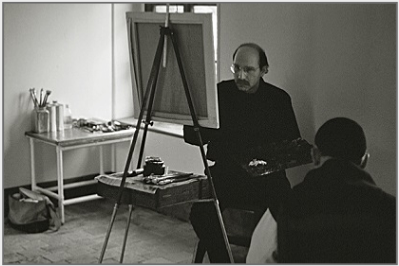
© Photo by Ronald Davis
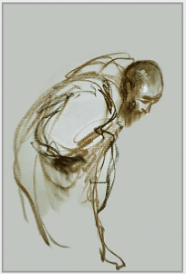
© Stanley Roseman

"The rigorous regime at La Trappe was taken up by other Cistercian abbeys in Europe. More Trappist monasteries were founded in the nineteenth century, including several in the United States. An independent branch of the Cistercian Order was established at a special chapter of the Trappist congregations held in Rome in 1892. The 'old' order, comprising those Cistercian monasteries that remained apart from the Trappist congregations, became known as the Order of Cistercians of the Common Observance. The Trappist congregations that formed a separate order acquired the name Order of Cistercians of the Strict Observance, familiarly called the Trappist Order."[5]
"The Rule of St. Benedict, Chapter 48, entitled 'The Daily Manual Labor,' instructs that the monks be engaged in work during prescribed times of the day as a balance to the hours devoted to prayer.
"The Trappists emphasized manual labor in their interpretation of the monastic precept ora et labora, prayer and work.
Davis' photographs complement Roseman's drawings and paintings on the monastic life and provide a visual record of the artist at work behind the monastery walls.
